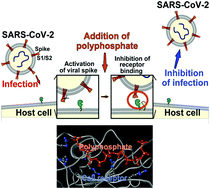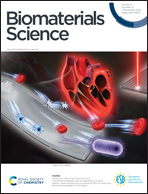The biomaterial polyphosphate blocks stoichiometric binding of the SARS-CoV-2 S-protein to the cellular ACE2 receptor
Abstract
The effect of the polyanionic polymer of inorganic polyphosphate (polyP) involved in innate immunity on the binding of the receptor-binding domain (RBD) of the SARS-CoV-2 spike protein to the cellular ACE2 receptor was studied. The RBD surface comprises a basic amino acid stretch of four arginine residues which interact with the physiological polyP (polyP40) and polyP3. Subsequently, the interaction of RBD with ACE2 is sensitively inhibited. After the chemical modification of arginine, an increased inhibition by polyP, at a 1 : 1 molar ratio (polyP : RBP), is measured already at 0.1 μg mL−1. Heparin was ineffective. The results suggest a potential therapeutic benefit of polyP against SARS-CoV-2 infection.

- This article is part of the themed collection: Coronavirus articles - free to access collection


 Please wait while we load your content...
Please wait while we load your content...